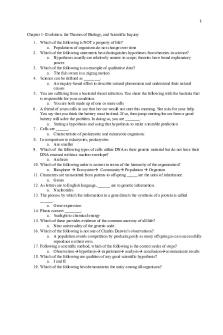Biol 114 Worksheet - Species Interactions PDF

| Title | Biol 114 Worksheet - Species Interactions |
|---|---|
| Course | Intro Bio: See Biol 114 |
| Institution | Binghamton University |
| Pages | 2 |
| File Size | 60.6 KB |
| File Type | |
| Total Downloads | 54 |
| Total Views | 164 |
Summary
Download Biol 114 Worksheet - Species Interactions PDF
Description
Biol 114 Worksheet: Species interactions 1) Species can partition their niches not just in space, but in time as well. The common spiny mouse (Acomys cahirinus) and the golden spiny mouse (A. russatus) live in rocky habitats of the Middle East and Africa, sharing similar microhabitats and food sources. Where they coexist, the common spiny mouse is nocturnal (active at night), while the golden spiny mouse is diurnal (active during the day). Laboratory research has shown that the golden spiny mouse is naturally nocturnal. Commonly, to test for the effects of competition, researchers will design a removal experiment where one species will be removed and the resulting distribution and behaviors of the other species are recorded. Then a second experiment is done where the second species is removed and the others’ responses recorded. Design an experiment that tests whether competition is dictating niche usage among the two species of mice. What results would you expect if competition is taking place? What if competition is not taking place? If competition is taking place one or both will change from fundamental to realized niche when both are present. The way to tell is if when removing one, the other changes. If it does, then we say it was in its realized niche before the removal and fundamental afterward. If it does not change with he removal, it was in its fundamental before the removal. 2) Explain how interspecific competition, predation, and mutualism differ in their effects on the interacting populations of two species. Interspecific competition -/- both suffer a cost in fitness through either scramble or interference Predation (and parasitism) are +/- there may be costs associated with the act of being a predator, but compared tot eh cost of the prey, it’s very small. Parasites don’t kill the host, parasitoids do. Mutualisms +/+ in either obligate or facultative.
3) Give an example of a pair of species that exhibit each interaction listed below. Provide also the cost benefit designations (+/+, +/-, +/0, -/-, -/0) for each interaction listed Interspecific competition (-/-) Hyenas and vultures at a carcass on the savanna. Predation (+/-) Cows eating grass. Parasitism (+/-) Tapeworm in human Parasitoidism (+/-) Parasitoid wasp and flies Herbivory (+/-) Gypsy moth caterpillars eating oak leaves Obligate mutualism (+/+) Cellulose digesting bacteria in herbivore Facultative mutualism (+/+) Bumble bee pollinating goldenrod flowers Symbiosis (+/-) or (+/+) Just means they live together all the time so a parasite works here. Lichens work as a mutualsim Commensalism (+/0) Burdock plant seed pods cling to mammal fur for dispersal Amensalism (0/-) Person walking across a lawn killing an insect in the grass.
4) For each of the mutualistic relationships listed, provide the costs and benefits to each species in the partnership. Ants and acacia trees Ants: costs are defense against herbivore and other plants, benefits are place to live and beltian bodies. Trees: cost is beltian bodies, and benefits are reduced herbivory and competition Coral polyps and zooxanthellae Coral costs, are space and energy to keep algae (risk of O2 toxicity), benefits carbohydrate, color and oxygen. Algae: cost losing carbs benefits place to live and CO2
Mycorrhizae and temperate deciduous trees Fungi costs giving up water and nutrients to trees, benefit is getting carbs. Trees: costs losing carbs, benefits getting water and nutrients
Blueberries and Chipmunks Plant: cost producing fruit takes energy, benefit is seed dispersal. Chipmunk cost is having to carry indigestible seeds around, benefit is sugars and other stuff from fruits
Rhizobium spp. bacteria and soy beans Bacteria cost is giving nitrogen to plants, benefit is getting carbs. Plant cost is losing carbs, benefit is getting usable nitrogen.
5) What general conditions must exist for a species to abandon a mutualistic relationship? If the cost of the relationship becomes greater than the benefit gained, that species should end the relationship.
6) Provide your paragraph (from lecture) on what the world would be like without mutualisms. How did you consider the assignment: Did you imagine a world that never had mutualisms, or one that suddenly lost its existing mutualisms? How would your response differ if you considered the other option?...
Similar Free PDFs

Symbiotic Interactions worksheet
- 2 Pages

Invasives species
- 3 Pages

L20 GRQs Community Interactions
- 2 Pages

morphological species concept
- 2 Pages

91602, 91607 Extinct Species
- 14 Pages

Dona Haraway Companion Species
- 3 Pages

Therapeutics Drug Interactions
- 10 Pages

Person-Situation Interactions
- 5 Pages
Popular Institutions
- Tinajero National High School - Annex
- Politeknik Caltex Riau
- Yokohama City University
- SGT University
- University of Al-Qadisiyah
- Divine Word College of Vigan
- Techniek College Rotterdam
- Universidade de Santiago
- Universiti Teknologi MARA Cawangan Johor Kampus Pasir Gudang
- Poltekkes Kemenkes Yogyakarta
- Baguio City National High School
- Colegio san marcos
- preparatoria uno
- Centro de Bachillerato Tecnológico Industrial y de Servicios No. 107
- Dalian Maritime University
- Quang Trung Secondary School
- Colegio Tecnológico en Informática
- Corporación Regional de Educación Superior
- Grupo CEDVA
- Dar Al Uloom University
- Centro de Estudios Preuniversitarios de la Universidad Nacional de Ingeniería
- 上智大学
- Aakash International School, Nuna Majara
- San Felipe Neri Catholic School
- Kang Chiao International School - New Taipei City
- Misamis Occidental National High School
- Institución Educativa Escuela Normal Juan Ladrilleros
- Kolehiyo ng Pantukan
- Batanes State College
- Instituto Continental
- Sekolah Menengah Kejuruan Kesehatan Kaltara (Tarakan)
- Colegio de La Inmaculada Concepcion - Cebu







